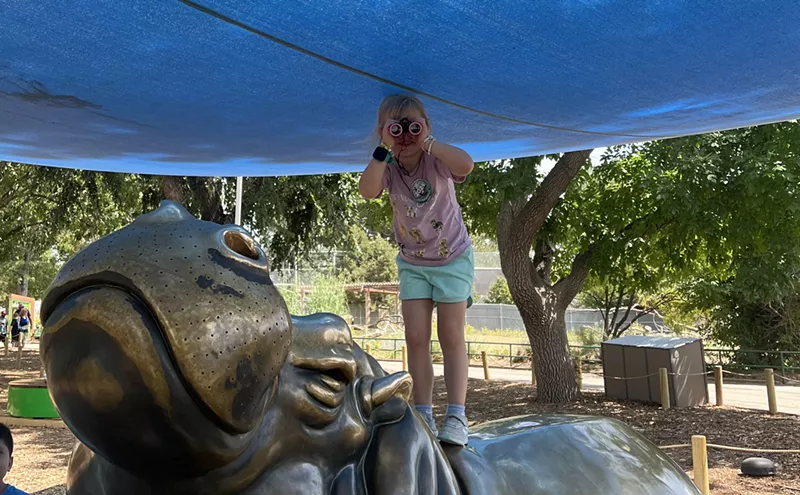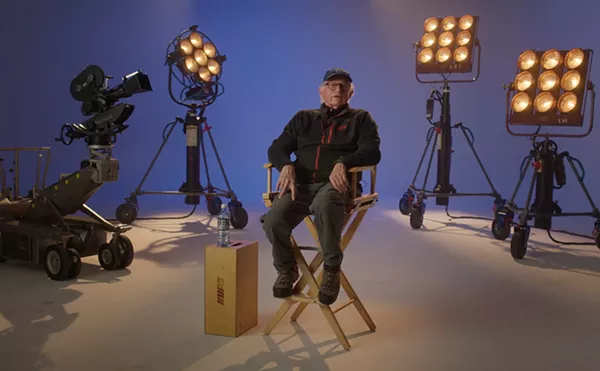The continuing and growing effect of this change in mindset is visible everywhere, particularly in the arts. Revivals and plays based on earlier sources dominate the Broadway stage. Remakes and retools of old movies attract big audiences -- and big awards. Many of the latest car designs reference the great-looking coupes and roadsters of the '50s and '60s, and much of today's wild, over-the-top furniture recalls that same visually rich period.
Looking in the rear-view mirror appears to be as cutting-edge as looking ahead.
The Denver art world is currently offering several first-rate examples of this new focus on the old. Among the best of the heady bunch is Duality/Autonomy, an exhibit with a decidedly '60s air to it. Smartly installed in the University of Denver's Victoria H. Myhren Gallery in the Shwayder Art Building, the show pairs recent paintings by Denver's Clark Richert with installations by New York's Devorah Sperber.
Duality/Autonomy is unusual and imaginative, deftly confronting the title's contradiction. Show organizer, DU professor and painter Jeffrey Keith divided the Myhren space in half with a freestanding temporary wall in order to present the ostensible duet as a pair of complementary solos -- a decision that was right on target.
Because of the obvious differences between Richert's and Sperber's work, Keith penned an essay pointing out some of their conceptual and stylistic affinities -- the most obvious being their shared interest in patterns.
Richert has worked with patterns for nearly forty years, but the paintings debuted in this show indicate an ideological change for the highly regarded artist. "It's so exciting to see an accomplished artist like Clark doing this kind of breakout work," Keith says, and I couldn't agree more.
Long interested in mathematics, Richert has always relied on grids and their rational regularity to organize his compositions, using them to convey either flatness or three-dimensionality. But in these latest paintings, he's added something different, something irrational -- the idea of randomness. Of course, we're talking about Richert, so it's to be expected that his randomness has been methodically calculated using complicated equations. The preliminary studies for the paintings were created on a computer, resulting in several blue backgrounds that evoke monitor screens.
In "64 Algorithms," a grid forms the outline of a cube that's subdivided into 64 smaller cubes. The grid defines the three-dimensional space falling behind the picture plane, the surface of which is defined by a legend of geometric shapes -- a device Richert often employs. Contained within the cube are multicolored wavy lines that create non-repeating patterns. But Richert introduces repetition anyway by lining up identical copies of the same pattern. In "Turbulence Machine," sinuous rainbow-hued lines float out in front of a light-blue graph-paper grid set at an angle, establishing the illusion of three dimensions on the dark-blue canvas.
The most radical Richert paintings are those that are essentially, if not completely, flat, such as "Snelsonian Motion" and -- even more so -- "R-P Motion," both of which represent a return to his earlier work. Richert has been abstractly illustrating imaginary three-dimensional spaces only since the 1980s; during the '60s and '70s, his paintings were utterly flat. Clearly, this revival of interest in flat patterns -- a hallmark of '60s abstract painting -- helps define the show's retro mood.
Helping even more are Sperber's subjects (bikinis, bandannas and a VW bus), which make up the other half of Duality/Autonomy. For the installation "VW Bus: Shower Power," Sperber conjures up a credible if vaporous rendition of the classic hippie van. She defines the form of the van by using bent aluminum tubing suspended from the ceiling and, hanging below, a clear vinyl curtain.
The image of the decorated van is almost photographic when seen from a distance. Up close, the recognizable image dissolves into geometric abstract patterns made of precisely lined-up rows of identical Chartpak vinyl flowers. In this way, the flowers carry out the photographic effects only through color changes, almost in the manner of a digital print. This relationship to digital technology is not casual: Sperber used computers to determine the flowers' placement in order to achieve a high level of photographic detail.
Despite the use of computers, a nostalgic feeling does pervade Duality/Autonomy; otherwise, I probably wouldn't have been humming Donavan's "Wear Your Love Like Heaven" as I made my way through it.
The revival of interest in '60s styles is also seen in a trio of shows at the Carson-Masuoka Gallery. But, as with Richert and Sperber over at DU, everything looks up to the minute.
In the front space is Sarah McKenzie: Survey, featuring contemporary representational paintings with a pop-art tinge. The paintings, generally aerial views of recently developed suburbs, have a limited palette; even the full-color paintings are mostly black, off-white and gray, just like the suburbs. Her style is reductive, with the houses simplified into geometric shapes enhanced by the irregular but monotonous street grids, linking her work to good old-fashioned pop art. One of McKenzie's strengths is her ability to capture reflected light, and her luminous paintings seem to emit an internal glow. Another notable feature of her work is the complicated compositions she prefers, lending her otherwise realistic paintings an abstract dimension.
Very different in style, though no less '60s-influenced, are the Necco-wafer-colored acrylics that make up Amy Sloan Kirchoff: Glimpses of the Continuum, a meditative exhibit installed in the center space at Carson-Masuoka. Compared to the work that Kirchoff exhibited last season, these new paintings mark a clear and major change. Compositions have virtually disappeared in favor of all-over color that suggest monochromes. However, under closer inspection, they are actually polychromes in layers of scribbled paint. All of these Kirchoffs are marvelous, but the biggest ones -- like "Ice Cream Sea," which literally froze me in my tracks -- are the best.
The last of the three shows at Carson-Masuoka is Bob Koons: Nearness of Distance, which is installed in the back conference room. Koons, who lives outside Boulder, does landscape abstractions that have a pop-art quality, though not in the same way as McKenzie's. Koons also plays with art history, tipping us off in his titles, such as "Freidrich...Fake!" I gather this is a parody of a painting by Casper David Freidrich, a nineteenth-century German romantic artist. In the painting, Koons reduces the landscape to a series of vague and blurry forms painted in toned-up, loosely naturalistic shades. Other Koons paintings refer to different nineteenth-century artists including Constable and Bierstadt. "I think he's one of the most exciting young painters around," says Mark Masuoka, the gallery's director and organizer of all three exhibits. "We plan to do a major show of his work in the near future." Hey, I'm already convinced by this small one, which I highly recommend.
The Carson-Masuoka exhibits provide three different approaches to contemporary painting that references classic modernism, and that theme carries across the street to Raw, a group show at the Space Gallery in the Goog Design Center.
Space, which opened downtown on Larimer Street just under two years ago, recently relocated to the ever-more-burgeoning Santa Fe arts district.
Young painter Michael Burnett, who hails from Scotland, runs the gallery and describes it as being partly an "extension" of his studio. No surprise, then, that the current show includes his recent work along with that of a group of other young artists. Burnett's style recalls mid-twentieth-century abstract expressionism, both in his huge, slashing brushstrokes that build gigantic abstract forms, and in his use of the natural properties of oil and resin.
I'd admired Burnett's style when I saw one of his paintings at Studio Aiello some months ago, but, to be honest, the reason I came into the new Space was to check out the elegant and well-made wall sculptures by Rand, an artist who eccentrically goes by his last name only. The sculptures sport forms made from altered wheel-turned ceramic vessels that have been mounted on aluminum plates. Several, including "Untitled," have bone-like appendages fired to a buff color. Rand's manipulated forms are made to a very high standard, and, amazingly, the rich surface effects he produces are the results of a glaze-less wood firing.
As I viewed his pieces, I was thinking he must have been influenced by Paul Soldner, one of the world's greatest ceramic artists who has been living part-time in Colorado since the 1960s. So when I ran into Rand at Space, I asked him how he'd come up with these expressionist abstractions in clay.
"When I was a kid, I was in workshops with Soldner," he said. Although Rand had other mentors when he studied at universities in this country and in Australia, Soldner's inspiration is still easy to see.
McKenzie, Kirchoff, Koons, Burnett and Rand are all young artists, yet all of them are responding to modern art that's older than they are -- the kind of art we expect from established artists like Richert and Sperber. Some may be troubled by this trend among twenty- and thirty-something artists, but I'm not. After all, as the art scene reveals every week, there are a lot worse things in this world than good old modernism.










